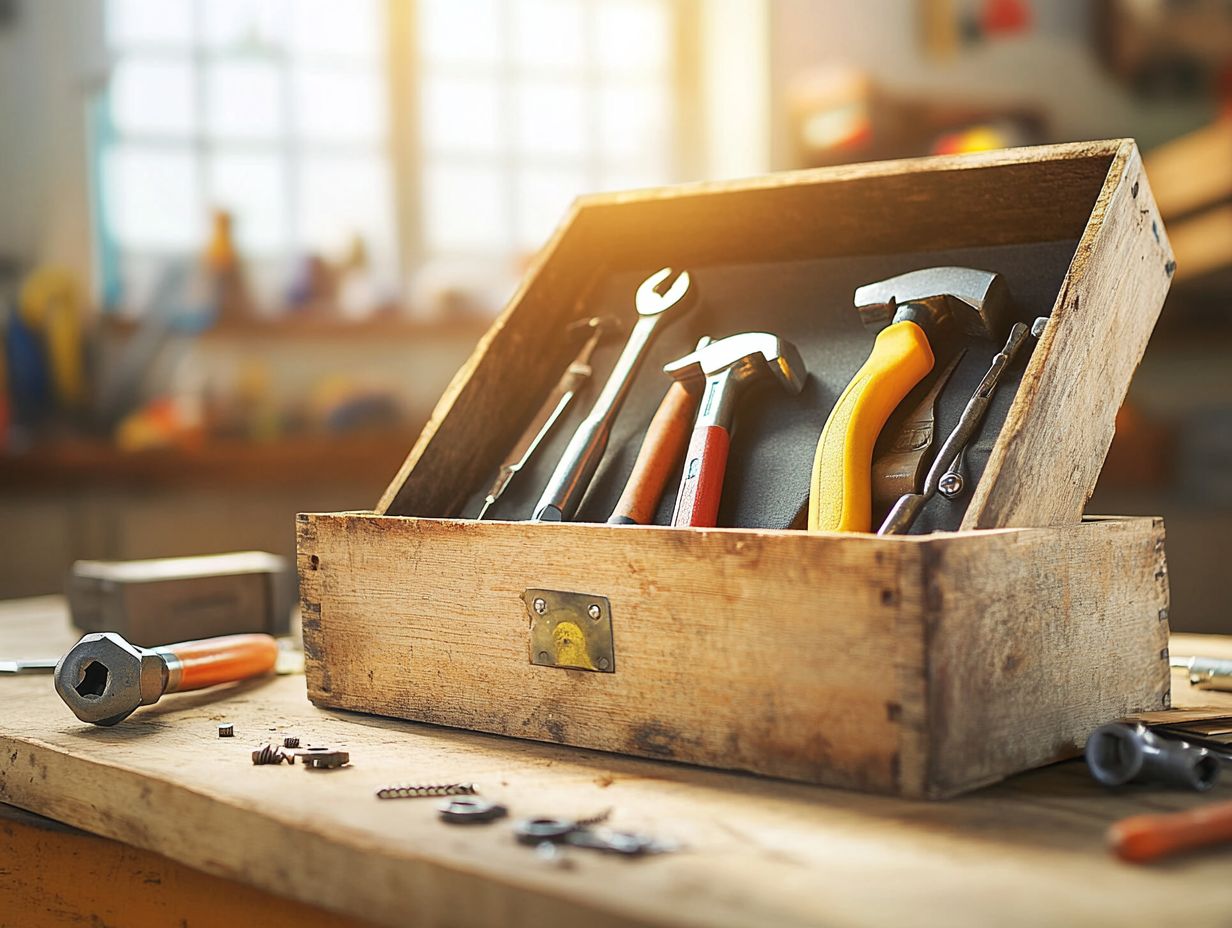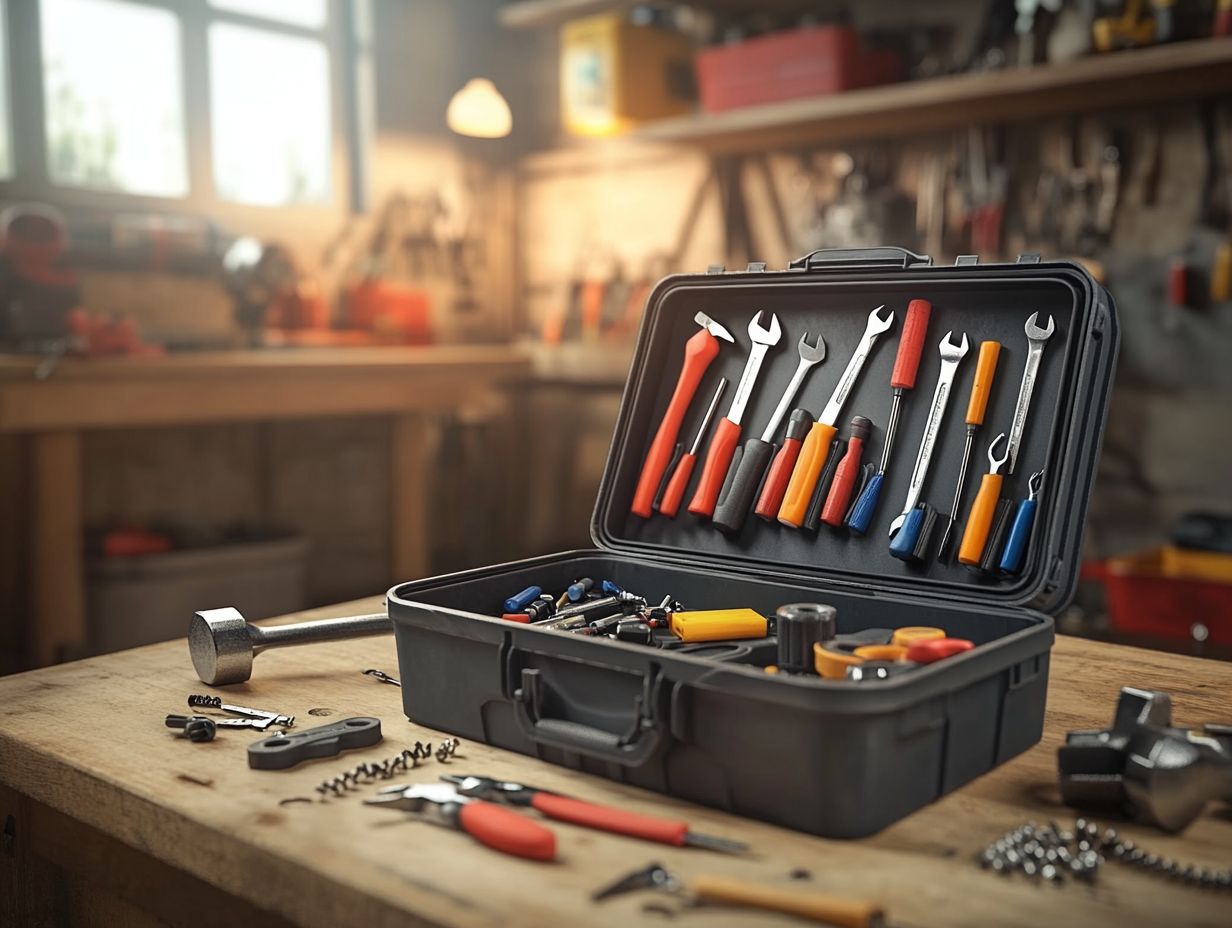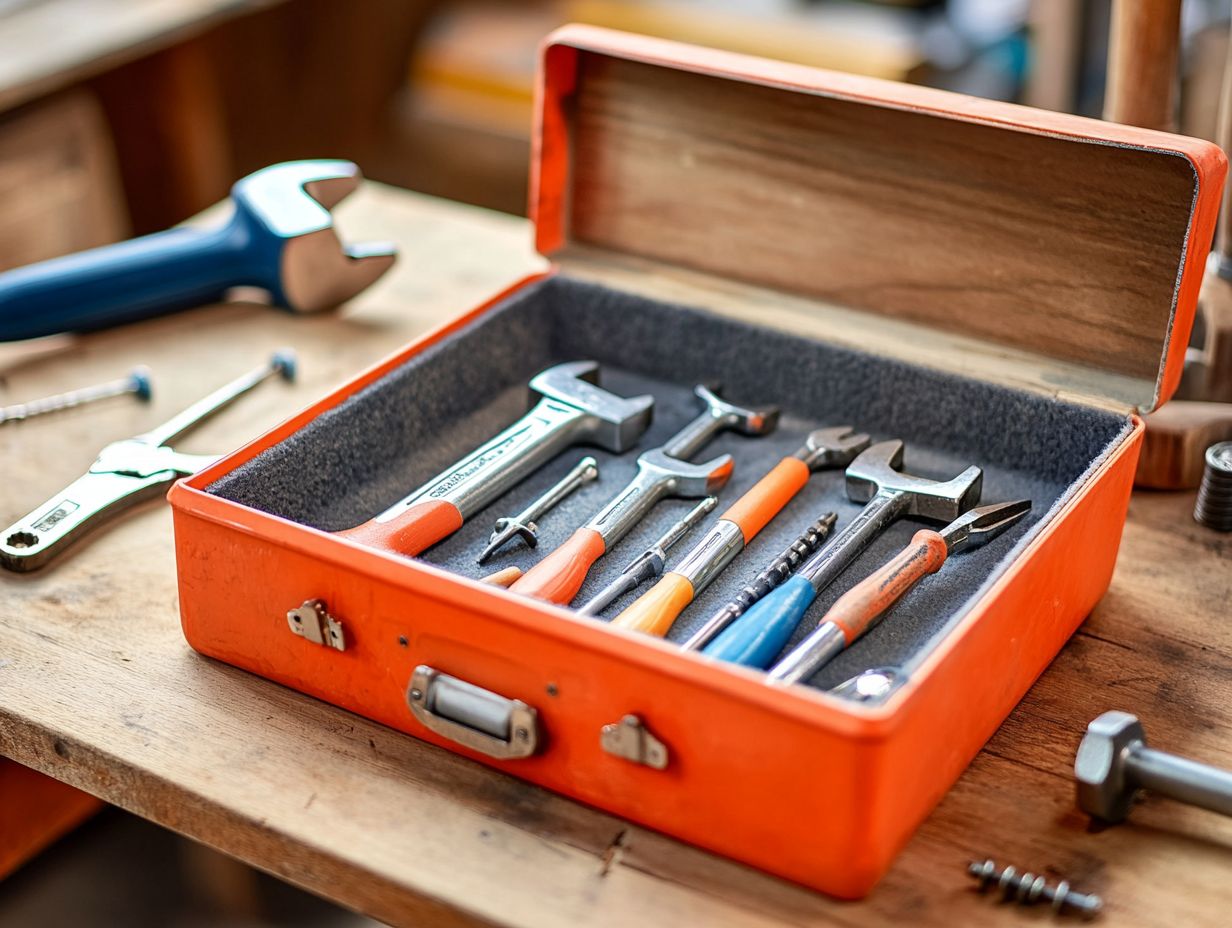Essential Tools for Home Repairs and Maintenance

Essential tools for home repairs and maintenance refer to any items necessary for conducting repairs and upkeep within a home. A well-equipped toolbox that includes hand tools, power tools, and safety equipment is crucial for performing repairs, maintenance, and home improvement projects. Additional items like a ladder, paintbrush, and caulk gun are also valuable for a variety of tasks around the house.
By investing in a diverse range of high-quality tools and equipment, homeowners can save time and ensure their homes remain functional and structurally sound. Proper tool maintenance, such as cleaning and storing tools correctly, further enhances their longevity and performance.
Must-Have Tools for Every Homeowner
Homeowners should equip themselves with essential tools to quickly handle common repairs and maintenance tasks around the house. A basic toolbox is crucial and should include a hammer, screwdriver, wrench, pliers, and a tape measure. Additional tools such as a stud finder and socket set can also be extremely useful. These fundamental tools enable homeowners to tackle minor repairs as they arise, promoting self-sufficiency.
A hammer is a vital tool for any homeowner and should be constructed from durable materials. It is versatile enough for various nailing jobs, from hanging pictures to completing flooring and framing tasks. Having a selection of nails and screws on hand can further expand the hammer’s utility.
Another essential tool is the screwdriver, which is used for fastening screws. Homeowners should have a sufficient set that includes both flathead and Phillips head screwdrivers in various sizes. For more specialized tasks, a socket wrench or torque wrench might also be required.
Wrenches are particularly useful for plumbing repairs and installations. A basic set should contain both open-end and adjustable wrenches to provide versatility for plumbing projects. Other essential plumbing tools include a pipe wrench and plumb bob for more precise measurements and adjustments.
Pliers are also fundamental tools that assist in gripping, bending, and cutting various materials. An adequate toolbox should include needle nose pliers, side cutting pliers, and slip joint pliers. Additionally, wire cutters are indispensable for electrical repairs.
A tape measure is critical for obtaining precise measurements, especially when hanging shelves, curtains, or artwork, and is also crucial for measuring dimensions during renovations. A suitable tape measure for a home toolbox should be at least 25 feet long, accommodating both indoor and outdoor measurements. For enhanced accuracy, a measuring tape paired with a level ensures that everything is aligned correctly.
A level is essential for ensuring that surfaces are straight and even. Many DIY projects, such as laying flooring or installing shelves and fixtures, benefit from the accuracy a level provides, enhancing the professional quality of the work.
A utility knife is a versatile tool ideal for cutting various materials, including cardboard, sheetrock, and carpet. Also known as box cutters, these tools come in different sizes. A good utility knife should feature a retractable blade and should be used solely for its intended purposes; it should not be employed as a screwdriver or pry tool. Keeping a supply of replacement blades ensures the knife remains sharp and effective.
Safety goggles are crucial for protecting eyesight when cutting or using other potentially hazardous tools. A basic pair of safety goggles should be included in the toolbox. In addition, a set of work gloves provides protection against cuts, abrasions, and other injuries.
Gloves are another essential item, providing safety during repair and maintenance tasks. Depending on the job, different types of gloves should be selected; heavy-duty gloves are recommended for cuts, burns, or scrapes, while insulated gloves should be used when working with electricity. Additionally, latex gloves can be useful for painting or using adhesives.
By having a basic toolbox that includes these essential tools, homeowners can efficiently address repairs and maintenance tasks without delay.
Power Tools for Home Improvement
Power tools have transformed home improvement projects by offering homeowners efficient and effective solutions for a wide variety of tasks. From drills that create precise holes to sanders that provide smooth finishes, the versatility of power tools gives homeowners the ability to handle projects ranging from simple repairs to extensive renovations. Proper tool maintenance ensures these tools perform at their best for years to come.
Additionally, tools such as nail guns and lawnmowers illustrate how power tools not only boost productivity but also enhance the quality of the work performed. Homeowners who embrace these tools can significantly elevate their DIY efforts. Tools like a pressure washer or hedge trimmer further extend the scope of maintenance and improvement tasks.
Benefits of Using Power Tools

Power tools provide numerous advantages that significantly enhance both the efficiency and quality of home repairs and improvement projects. Unlike traditional hand tools, power tools are specifically designed to perform tasks more quickly and with greater precision, enabling homeowners to complete projects in a fraction of the time. For optimal performance, keeping an extension cord handy can ensure that power tools are used efficiently even in areas far from electrical outlets.
The craftsmanship made possible by power tools ensures that repairs are not only faster but also of superior quality, making them a valuable investment for any homeowner. The wide variety of power tools available caters to diverse needs, making DIY projects more accessible to everyone.
For instance, tools like cordless drills and circular saws can dramatically reduce the time required to assemble furniture or cut through materials, thereby improving the overall quality of the project while allowing for larger jobs to be tackled with less physical strain than manual labor typically involves.
Specialty tools, such as oscillating multi-tools, enhance precision in tight spaces, facilitating intricate work that would otherwise be challenging. This increased efficiency and the ability to manage complex tasks encourage homeowners to undertake bolder home improvement projects, transforming their living spaces with confidence.
Top Power Tools for Home Use
The power tools most suited for home use are effective and versatile for a variety of tasks. Essential power tools to have at home include:
- a drill for making precise holes,
- a circular saw for cutting wood,
- a sander for achieving a smooth finish on various surfaces,
- a caulk gun for applying sealants and adhesives.
Additionally, lawnmowers play a crucial role in maintaining outdoor spaces, ensuring that the yard remains neat and tidy. Other garden tools, such as a hose, rake, and shovel, are also essential for yard work. Investing in these important power tools can significantly enhance the efficiency of home projects. Each of these tools offers unique benefits that are valuable for both small repairs and larger renovations.
The drill, for example, can accommodate various attachments, providing diverse functionality that allows it to serve as a screwdriver and even as a hammer for drilling into concrete. The circular saw is capable of cutting through multiple materials beyond wood, making it a favorite among DIY enthusiasts. The sander is critical for smoothing surfaces, whether preparing wood for staining or painting or restoring old furniture.
To ensure the longevity and effectiveness of these tools, proper care and maintenance are essential. This includes regularly cleaning the circular saw blades, keeping the battery charged, and maintaining the power cords, which help guarantee that they are always ready for use in completing home tasks. Additionally, storing tools in a workbench can keep them organized and easily accessible.
Hand Tools for DIY Projects
Hand tools remain essential for DIY projects, providing homeowners with the necessary equipment to make precise repairs and improvements at home. Tools such as screwdrivers, hammers, pliers, and tape measures enable DIY enthusiasts to make accurate adjustments in ways that power tools cannot. Other hand tools like chisels and clamps are invaluable for more intricate work and ensuring secure holds.
Along with being crucial for basic home repairs, hand tools give the power to individuals to undertake creative DIY projects, allowing them to personalize their living spaces. Learning to use hand tools fosters a sense of pride and competence in homeowners, enhancing their skills and confidence in their abilities.
Types of Hand Tools

A comprehensive list of various types of hand tools includes screwdrivers, wrenches, pliers, and utility knives.
These hand tools are essential for a range of tasks: screwdrivers are used for fastening or loosening, wrenches for gripping and turning, pliers for gripping and cutting, and utility knives for cutting. Each tool serves a specific purpose and enhances the overall functionality of a toolkit.
With the right hand tools, homeowners can tackle a variety of projects around the house. It is crucial to select the appropriate hand tools for specific tasks by considering factors such as size, material, and ergonomic design to ensure comfort during extended use. For example, a plumb bob can aid in achieving precise vertical alignment, while a workbench provides a stable surface for various tasks.
For instance, a screwdriver set with various heads allows for versatile applications, while a ratcheting wrench offers improved access in tight spaces compared to traditional models. Investing in high-quality pliers can also enhance gripping strength, making it easier to handle stubborn materials.
Uses and Benefits of Hand Tools
Hand tools offer unique advantages that enhance the precision and control needed for various maintenance and repair tasks. They are especially beneficial for delicate jobs where power tools may be too aggressive, allowing homeowners to work with greater care and accuracy. Additionally, hand tools typically require less setup and maintenance than powered tools, making them more convenient for quick fix-it projects around the house. Items like adhesive and electrical tape can also be handy for immediate repairs. Overall, using hand tools can lead to increased satisfaction and confidence in DIY endeavors.
For instance, during delicate tasks such as installing hardware or repairing furniture, the control provided by handheld screwdrivers and chisels can be essential. Unlike power tools, which can overdrive screws and splinter wood, hand tools allow for a gradual application of force. Many users report that the tactile feedback from hand tools enhances their ability to gauge pressure and placement, creating a more intuitive experience with DIY projects. Other tools like a scraper or paint thinner can be vital for surface preparation and final touches.
Incorporating essential tools like a wrench, screwdriver, and pliers into a home maintenance toolbox not only gives homeowners the power to tackle projects with confidence but also fosters a deeper appreciation for the craft of DIY work.
Safety Tips for Using Tools at Home
Safety is paramount when using tools at home, as improper usage can lead to serious injuries and accidents. Homeowners should equip themselves with basic safety equipment, including work gloves to protect their hands, safety goggles to shield their eyes, and appropriate clothing to minimize the risk of injury while repairing and maintaining their homes.
Understanding and applying safety tips for both hand tools and power tools can prevent accidents and help maintain a safe environment for all DIY projects. This includes using proper tools like a drill or a saw safely.
Precautions and Best Practices

Taking precautions and adhering to best practices when using tools can significantly minimize accidents and injuries at home. It is essential to understand the operation of each tool, wear appropriate safety gear such as goggles and gloves, and work in a well-organized environment free of hazards. Proper maintenance and following the manufacturer’s instructions enhance both the safety and efficiency of tools, enabling homeowners to make repairs safely and promptly.
Additionally, having the right tools like a hammer, tape measure, and utility knife can make your projects more efficient and safer.
Taking precautions and adhering to best practices when using tools can significantly minimize accidents and injuries at home. It is essential to understand the operation of each tool, wear appropriate safety gear such as goggles and gloves, and work in a well-organized environment free of hazards. Proper maintenance and following the manufacturer’s instructions enhance both the safety and efficiency of tools, enabling homeowners to make repairs safely and promptly.
Tool Safety Precautions
- Regularly inspect tools to ensure they are in good working condition and to identify any wear or damage that could impair performance. Tools like a socket set, plumb bob, and workbench should be kept in good shape.
Power Tool Safety Precautions
- Use the correct extension cords and ensure they are rated for the power tool you are using. This is crucial for tools like a drill, saw, and vacuum.
Hand Tool Safety Precautions
- Grip tools correctly and maintain stable footing to avoid slips that could result in injuries. This is especially important when using tools like a ladder, crowbar, or sledgehammer.
Tool Safety Education
Homeowners can benefit from workshops or online courses that teach tool safety, as safety practices continue to evolve. Staying up to date on these practices can make a significant difference in daily tool use. Consider learning about the safe use of a caulk gun, stud finder, and socket wrench.
Maintaining and Organizing Your Tool Collection
The importance of tool maintenance and organization lies in ensuring efficiency, safety, and the longevity of the tools. A well-organized toolbox makes it easier to locate the right tools, while regular maintenance prevents wear and tear that could compromise both performance and safety.
By properly organizing and maintaining their tools, homeowners can maximize their utility. Tools like a level, flashlight, and paintbrush should be easily accessible.
The importance of tool maintenance and organization lies in ensuring efficiency, safety, and the longevity of the tools. A well-organized toolbox makes it easier to locate the right tools, while regular maintenance prevents wear and tear that could compromise both performance and safety.
By properly organizing and maintaining their tools, homeowners can maximize their utility.
Tips for Proper Maintenance
Proper maintenance of tools is essential for ensuring their longevity and optimal performance during home repairs and maintenance tasks. Regularly cleaning tools after use, checking for wear and tear, and promptly replacing worn parts can significantly extend the life of both hand and power tools. Additionally, periodic inspections and storing tools in a secure, dry environment further protect them from damage, allowing homeowners to rely on their tools for years to come. For example, cleaning and oiling tools like chisels, clamps, and a pipe wrench can keep them in top condition.
Good maintenance habits not only help avoid unnecessary costs associated with frequent replacements and repairs but also lead to more efficient and safer tools. For example, keeping tools clean from dust and grime enhances their efficiency and prevents rust from forming on metal components.
Inspecting cords and connectors for fraying and damage is crucial for power tools, as it ensures safety during use. Regularly lubricating moving parts and tightening loose screws greatly affects a tool’s functionality and safety. Creating a detailed maintenance checklist can aid in performing these tasks consistently and effectively. This checklist should include tasks like checking the performance of torque wrenches and ensuring the blades of hedge trimmers and lawn mowers are sharp.
Organizational Strategies for Easy Access
Implementing effective organizational strategies for your tools can ensure easy access during home repair and maintenance tasks. A well-thought-out toolbox layout, along with designated storage solutions, enables homeowners to quickly locate the tools they need, minimizing downtime and frustration.
Consider categorizing tools by type or frequency of use and investing in storage solutions such as pegboards or tool chests to keep your workspace tidy and efficient. These strategies not only enhance workflow but also promote a safer working environment. Utilizing labeled drawers or clear bins for small items like screws, nails, and fasteners can make your workspace more orderly.
To further improve organization, individuals can use clear bins or labeled drawers to visually categorize smaller items like screws, nails, and fasteners, making them easier to find at a glance. It is also beneficial to keep frequently used items at eye level, ensuring they are accessible and visible when needed. Keep critical items like a scraper, spackle, and sandpaper within reach for quick access during projects.
Additionally, incorporating a designated area for safety gear, such as gloves and goggles, serves as a reminder for homeowners to prioritize safety while they work. Regularly assessing and decluttering your tool collection ensures that only essential tools remain, contributing to a more streamlined and efficient workspace. Including items like caulk, wood glue, and adhesive in your inventory can ensure you have the necessary supplies for any task.


